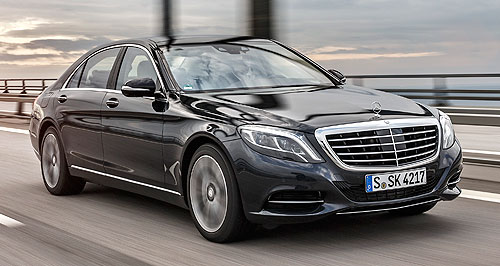News - Mercedes-BenzDaimler outlines electrification strategyCell block: The GLC F-Cell is claimed to be the first production car in the world to combine hydrogen-fuelled battery technology with plug-in charging capability for a range of 500km. Petrol, diesel, micro and plug-in hybrid all slated for Benz investment15 Jun 2016 DAIMLER will commit more than half its €14.5 billion ($A22m) two-year research and development budget towards ‘green’ investment, focusing funds on a four-point strategy that includes the expansion of hybrid, electric and fuel-cell vehicles, and associated battery and charging technology. Passenger cars will snare €5.4 billion ($A8.2b) of the “more than” €7 billion ($A10.6b) set aside for the development of what Daimler describes as “green powertrain technologies” and which will see all Mercedes-Benz models electrified in the coming years. A new modular petrol and diesel engine family has already been announced, the first of which has made its debut in the E220d where substantial reductions in internal friction aid a 13 per cent reduction in fuel consumption compared with its equivalent predecessor. However Benz has now said it will follow Audi’s lead and offer 48-volt electrical systems in its non-hybrid models to permit “energy recovery” and “boost” features, plus a low-speed “electric mode”, without heavy and costly high voltage components. The micro-hybrid system will fill the gap between petrol/diesel models and the further rollout of plug-in hybrids that now also includes a fuel-cell vehicle. The GLC F-Cell is claimed to be the first production car in the world to combine hydrogen-fuelled battery technology with plug-in charging capability to provide around 500km total range. The brand has also confirmed a GLC350e Coupe and E350e sedan will be introduced before the end of 2016 as the brand’s seventh and eighth fossil fuel/battery powered models. Each will borrow heavily from the existing C350e (sedan, Estate and China-only long-wheelbase), GLE350e/GLE500e and S500e as part of Benz’s modular architecture strategy designed to keep costs down. “(Intelligent Modular Hybrid Concept) is scalable to allow it to be transferred to a number of model series and body styles as well as left-hand-drive and right-hand-drive variants,” the company said in a statement. Benz has also confirmed it will update the S500e next year to include “contactless charging” that has been in testing since 2015 and the technology is expected to trickle down to other models. The wireless charging set-up will require two components placed on a garage floor or protected area including a base plate with integrated primary coil to connect with a secondary coil in the vehicle’s floor. The driver would be required to drive over the base plate and a cockpit display message would alert the driver charging has commenced. The update will coincide with the addition of new lithium-ion batteries that increase the limousine’s electric-only range from 33km to 52km. Daimler claims it is the only German car manufacturer to own its own battery company, Deutsche Accumotive, and as part of its investment it predicts in the next decade post-lithium-ion technology will see “energy density double and costs halve” to dramatically boost electric vehicle range and make electric vehicles more affordable. From 2018 it also expects direct current charging to debut as part of Combined Charging System (CCS) that “expands the existing technical standard for AC charging of electric vehicles with the capacity for DC fast charging” and could permit a 150kW charging capacity with future capability of up to 350kW. At the Paris motor show in September, fellow Daimler brand Smart will also become the first passengercar brand in the world to entirely electrify its range, with the Fortwo, Fortwo cabriolet and Forfour electric drive models confirmed to make their global debut. The trio will go on-sale in the US, which has previously acquired 25 per cent of all battery powered Smarts sold, before the end of the year. In a lengthy investment statement that covers development of petrol, diesel, micro-hybrid, plug-in hybrid, plug-in hybrid plus hydrogen and full electric models, Daimler AG member of the board of management and head of group research and Mercedes-Benz development Thomas Weber added, “all the mentioned types of powertrains have their justification and chances”. “As a matter of fact, no other manufacturer offers a comparable range of electrified vehicles and solutions in the field of electric mobility,” he continued in a statement. “We will electrify all Mercedes-Benz passenger-car model series step by step. Customers are not looking to sacrifice in the sense of ‘less car’ (but) in the contrary. That is why we emphasise enhanced efficiency through more intelligent technology – and we do it consistently in all model series. “We are investing massively in electromobility, and we are convinced that the market is now ready. With the new vehicles we offer, we want to impress the benefits of the new mobility on car owners who have not yet opted for an electric vehicle.”  Read more14th of June 2016  Daimler kicks off home battery rolloutMercedes-Benz Energy to produce stationary and automotive energy storage systems30th of May 2016  Mercedes investing $4.7b in new enginesSignificant engine investment paying off for Mercedes with shrinking emissions11th of April 2016  Mercedes working on E-turboElectric blower under evaluation by Benz to commit turbo lag to history8th of April 2016  Daimler working on grass-roots shake-upMore nimble structure planned so Mercedes can counter tech 'disrupters' |
Click to shareMercedes-Benz articlesResearch Mercedes-Benz Motor industry news |



































Facebook Twitter Instagram